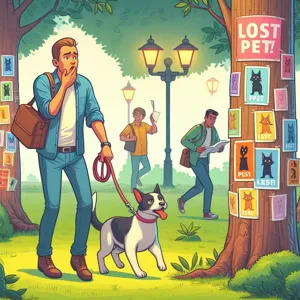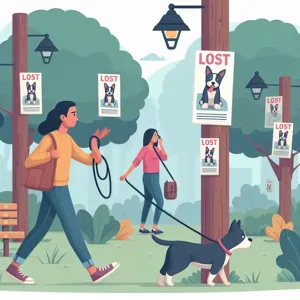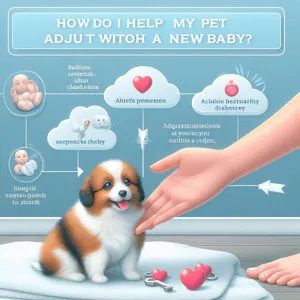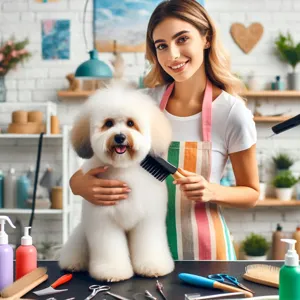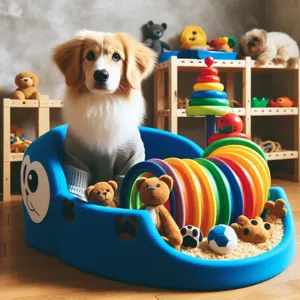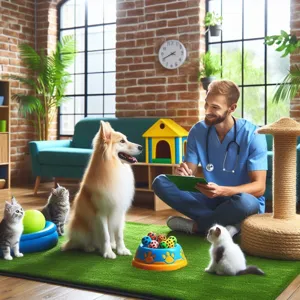Finding the perfect family car can be a daunting task, especially when you want to ensure that it meets the needs of not just the humans in your household, but also your beloved furry companions.
After all, family road trips and daily commutes are more enjoyable when everyone, including pets, can travel comfortably and safely. In this blog post, we’ll explore the top 10 family-friendly cars that not only offer ample space and convenience for your family but also provide a pet-friendly environment that your four-legged friends will adore. From spacious interiors designed for easy entry and exit to features that make clean-up a breeze, these vehicles prioritize comfort and safety for all passengers. So buckle up and get ready to discover the perfect ride that keeps both your family and pets happy on the road!
1. Introduction: The Importance of Choosing a Family-Friendly Car for Pets
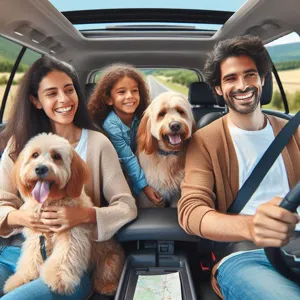
When it comes to selecting a family-friendly car, the needs of our furry companions are just as crucial as those of our human family members. Pets are more than just animals; they are beloved members of our households, and ensuring their comfort, safety, and happiness during travels is essential. A family-friendly car is one that accommodates not only the kids but also the four-legged friends who often join us on road trips, errands, and weekend getaways.
Choosing the right vehicle can make all the difference in creating a positive travel experience for everyone on board. Factors such as spaciousness, ease of access, and safety features play a significant role in ensuring that your pets are comfortable and secure. For instance, a car with a low step-in height makes it easier for older pets or those with mobility issues to hop in and out, while ample cargo space allows for pet carriers, crates, and all the necessary gear.
Moreover, certain materials and features can help mitigate the wear and tear that pets can inflict on your vehicle’s interior, from durable upholstery that resists scratches and stains to built-in pet barriers that keep your furry friends safely in the back. Additionally, having features like rear air vents can ensure that all passengers, including pets, stay cool and comfortable during the drive.
As we delve into our top picks for family-friendly cars that your pets will love, it’s important to remember that the right vehicle can transform every journey into a delightful adventure, making trips to the park, vet, or even family vacations a breeze for both you and your pets. Let’s explore the top ten options that blend functionality, safety, and comfort, ensuring that your entire family—two-legged and four-legged alike—travels in style and ease!
2. Key Features to Consider for Pet-Friendly Vehicles
When selecting a family-friendly vehicle that accommodates your furry friends, there are several key features to consider that can make all the difference in ensuring comfort, safety, and convenience for both pets and humans alike.
**1. Spacious Interiors:** One of the first things to look for is ample cabin space. A roomy interior allows your pets to stretch out, lie down, and move comfortably during travels. Consider vehicles with adjustable seating arrangements, like SUVs and minivans, which can provide extra legroom and cargo space for pet gear.
**2. Easy-to-Clean Materials:** Pets can be messy, so opting for vehicles with durable, easy-to-clean upholstery is crucial. Look for fabric options that resist stains and odors, as well as rubberized flooring that can handle muddy paws and shedding fur. Some manufacturers even offer pet-friendly interior packages designed specifically for easy cleanup.
**3. Safety Features:** Your pet’s safety should be a top priority. Look for vehicles equipped with safety features such as rear airbag cutoffs, child safety locks, and sturdy seat belts. Additionally, consider investing in pet harnesses or travel crates that can secure your pets during the ride, minimizing the risk of injury in case of sudden stops.
**4. Built-In Pet Amenities:** Some modern vehicles come with built-in pet amenities that can enhance your travel experience. Features like pet barriers, built-in water bowls, and specially designed cargo areas with non-slip surfaces can make trips more enjoyable for your furry family members.
**5. Climate Control:** Just like humans, pets can be sensitive to temperature changes. A vehicle with dual-zone climate control ensures that your pets remain comfortable, regardless of the weather outside. Look for features like rear ventilation to keep the air circulating in the back seats where your pets will likely hang out.
By prioritizing these key features, you can ensure that your vehicle not only meets the needs of your family but also provides a safe and comfortable environment for your beloved pets. Choosing the right car will pave the way for enjoyable road trips, weekend getaways, and everyday adventures with your furry companions!
3. Safety First: Ensuring Your Pets are Secure During Travel
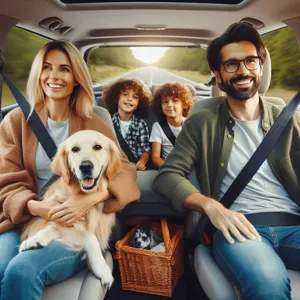
When it comes to family-friendly cars, ensuring the safety of your pets during travel is just as crucial as securing your human passengers. A comfortable ride is only part of the equation; the right vehicle should also prioritize security features that keep your furry friends safe throughout the journey.
First and foremost, look for vehicles equipped with adequate pet restraints or harnesses. Many modern cars come with built-in tethering systems that allow you to securely fasten your pet’s harness to the seat, minimizing the risk of injury in case of sudden stops or accidents. Additionally, consider vehicles that offer spacious back seats, as this ensures your pets have enough room to move around comfortably while still being safely secured.
Another important feature to consider is the presence of a low cargo area or a flat load floor. This makes it easier for pets to hop in and out of the car without straining their joints, especially in senior pets or those with mobility issues. Moreover, a vehicle with a dedicated pet barrier can help keep your furry friend contained in the back, preventing distractions while you drive.
Ventilation is also key to ensuring your pets are comfortable during travel. Look for cars that provide ample airflow through windows or vents, and consider those with rear air conditioning systems to keep the temperature just right, especially on warmer days.
Lastly, don’t overlook the importance of easy-to-clean interiors. Accidents happen, and a vehicle with durable, stain-resistant materials will save you time and hassle after a long road trip. By prioritizing these safety features, you can ensure that your pets are not only comfortable but also secure, making every journey a joy for the entire family.
4. Top 10 Family-Friendly Cars Overview
When it comes to finding the perfect family-friendly car, pet owners have unique considerations to keep in mind. Whether you’re carting around kids, furry companions, or both, the ideal vehicle should offer ample space, comfort, and safety features tailored to everyone in the family. In this overview, we’ll delve into the top 10 family-friendly cars that not only cater to your children’s needs but also ensure your pets can travel in style and comfort.
Each vehicle on this list has been carefully selected based on key criteria: spacious interiors for stretching out, easy-to-clean materials for those inevitable messes, and safety features that give you peace of mind on the road. From SUVs with expansive cargo areas perfect for pet crates to sedans that offer a cozy ride for small dogs, we’ve got something for every family dynamic.
As we explore these models, we’ll highlight their standout features, such as adjustable seating configurations, built-in pet barriers, and even pet-friendly accessories that make traveling with your four-legged friends a breeze. Whether you’re planning a quick trip to the park or embarking on a long road trip, these cars are designed to make every journey enjoyable for both kids and pets alike. Get ready to discover your next family vehicle that ensures every member of your household—two-legged and four-legged—travels in comfort and style!
5. Car #1: Features and Benefits for Families and Pets

When it comes to choosing the perfect family-friendly car, the **2023 Subaru Outback** stands out as a top contender that caters not only to families but also to their beloved pets. With its robust design and an array of thoughtful features, the Outback combines safety, comfort, and versatility, making every journey a joy for both humans and furry companions.
### Spacious Interior
The Subaru Outback boasts an expansive interior, providing ample room for both family members and pets. With up to 75.7 cubic feet of cargo space when the rear seats are folded down, there’s plenty of room for pet crates, toys, and all the essentials for a family road trip. The low cargo floor also makes it easy for your pets to hop in and out without straining their joints.
### Safety First
Safety is paramount for any family vehicle, and the Outback excels in this area. It comes equipped with Subaru’s EyeSight Driver Assist Technology, which includes features like adaptive cruise control and lane-keeping assist. Additionally, the Outback has received top safety ratings, ensuring that your family—furry members included—are protected on every adventure.
### Pet-Friendly Features
The Subaru Outback is designed with pets in mind. Optional accessories such as pet-friendly seat covers and a rear seat protector keep your car clean from muddy paws and shedding fur. The Outback also offers a built-in pet harness system, ensuring that your furry friends are safely secured during travel, reducing distractions and ensuring peace of mind.
### Comfort and Convenience
Long drives can be challenging for pets, but the Outback makes every journey comfortable. The supportive seating and quiet cabin reduce stress for both pets and passengers, while the available panoramic sunroof allows your pets to enjoy the view as you cruise down scenic routes. With multiple USB ports and an intuitive infotainment system, you can keep your family entertained while on the go.
In conclusion, the **2023 Subaru Outback** is not just a car; it’s a family-friendly vehicle that understands the importance of including every member of the family, including pets. With its spacious interior, advanced safety features, and thoughtful pet-friendly accessories, the Outback is sure to make every trip a delightful experience for everyone involved. Whether it’s a quick errand or a cross-country adventure, this car is ready to take on the open road with your loved ones—both two-legged and four-legged!
6. Car #2: Family Comfort and Pet Accessibility
When it comes to family-friendly cars that prioritize both human comfort and pet accessibility, the **Honda Odyssey** stands out as an exceptional choice. This minivan is designed with a spacious interior that caters to families of all sizes, making it an ideal vehicle for those who travel with furry companions.
One of the Odyssey’s most notable features is its configurable seating arrangement. With seating for up to eight passengers, you can easily create extra space for your pets by folding down the seats or utilizing the expansive cargo area. The low floor height ensures that your pets can hop in and out with ease, eliminating any struggles for smaller or older animals.
Pet owners will appreciate the Odyssey’s thoughtful design elements that make it easy to keep the interior clean. The available leather upholstery not only adds a touch of luxury but also simplifies cleanup after a day spent at the dog park. In addition, the built-in vacuum cleaner—known as the HondaVac—ensures that any stray fur or crumbs can be swiftly eliminated, keeping your vehicle tidy for the next family adventure.
Safety is a top priority in the Honda Odyssey, featuring advanced driver-assist technologies that offer peace of mind while on the road. With its suite of safety features, you can focus on enjoying family outings without constantly worrying about your pets’ well-being.
Furthermore, the Odyssey’s entertainment system, complete with rear-seat entertainment options, keeps both kids and pets entertained during longer trips. Whether it’s playing their favorite movie or soothing music, everyone in the car can enjoy a pleasant ride.
In summary, the Honda Odyssey perfectly balances family comfort with pet-friendly accessibility, ensuring that every journey you take is enjoyable for both your loved ones and your four-legged friends. Whether it’s a trip to the vet or a family vacation, this minivan is equipped to handle it all with style and ease.
7. Car #3: Roomy Interiors for Kids and Pets

### 7. Car #3: Roomy Interiors for Kids and Pets
When it comes to family-friendly vehicles, spacious interiors can make all the difference—especially when you have both kids and furry companions to accommodate. Enter the **Honda Odyssey**, a minivan that effortlessly combines comfort, versatility, and roominess, ensuring that every family member, including your pets, enjoys the ride.
With its generous cabin space, the Odyssey boasts three rows of seating that can comfortably fit up to eight passengers, leaving plenty of room for your pets to stretch out. The wide rear sliding doors make it easy for your little ones to hop in and out, while also providing ample space for your dogs to enter without a fuss. The optional second-row captain’s chairs create a pass-through area that makes it easy for kids to access their toys and snacks, while also giving pets a cozy spot beside them.
What truly sets the Odyssey apart is its thoughtfully designed interior that includes durable, easy-to-clean upholstery—perfect for those unexpected messes that come with both kids and pets. The floor is low and flat, providing a stable surface for your pets to settle down during longer drives. With ample cargo space behind the third row, you’ll find enough room to stow away pet supplies, strollers, and all the essentials for family outings.
Plus, the Odyssey features a built-in vacuum system—yes, you read that right! This innovative addition allows you to quickly clean up any spilled treats or pet hair, making post-adventure clean-ups a breeze. Whether you’re heading to the park for a day of play or embarking on a family road trip, the Honda Odyssey ensures everyone, including your furry friends, travels in comfort and style. With its spacious interiors and family-oriented features, this car is truly a haven for both kids and pets alike!
8. Car #4: Easy-to-Clean Materials for Kid and Pet Messes
When it comes to family-friendly cars, one essential feature that can make or break your experience is the ease of cleaning. Kids and pets are notorious for turning even the tidiest of vehicles into a chaotic mess, whether it’s crumbs from a hurried snack, muddy paws after a long walk, or the occasional spilled drink. This is where our fourth pick shines, equipped with easy-to-clean materials that help you maintain a sense of order amidst the whirlwind of family life.
Imagine a spacious interior featuring durable, stain-resistant upholstery that can stand up to the rigors of family outings. Many manufacturers are now opting for synthetic materials that not only offer the soft feel of fabric but also provide the resilience needed to combat spills and scratches. Look for options like leatherette or treated fabrics that can be wiped down quickly, along with floor mats that are removable and washable, ensuring that a simple rinse can restore your car’s interior to its former glory.
Additional smart design choices, such as well-placed storage compartments and cupholders, make it easier to keep things organized and minimize the potential for mess. Consider features like a pet-friendly rear seat cover that can be easily removed and cleaned, allowing your furry companions to travel comfortably without leaving a trail of fur and dirt behind.
Moreover, some cars even incorporate a vacuum system right into the vehicle, making cleanup after a spontaneous road trip or a day at the park easier than ever. With these thoughtful touches, you can enjoy peace of mind knowing that your family—and your pets—can indulge in their adventures without you constantly worrying about the aftermath. Choosing a car with easy-to-clean materials means more time enjoying the journey and less time stressing over the cleanup, making it a perfect fit for families on the go!
9. Car #5: Fuel Efficiency for Family Road Trips with Pets
When it comes to family road trips, especially those that include furry companions, fuel efficiency becomes a critical factor in your vehicle choice. Enter Car #5, a standout option that combines spaciousness and comfort with impressive miles per gallon, ensuring that long drives are both economical and enjoyable.
This vehicle’s sleek design and aerodynamic shape not only enhance its aesthetic appeal but also contribute to its fuel-saving capabilities. With a robust engine that delivers power without guzzling gas, you can explore national parks, scenic byways, and pet-friendly beaches without constantly worrying about how much you’re spending at the pump.
Inside, Car #5 prioritizes comfort for both humans and pets. The spacious interior provides ample room for your family and their four-legged friends, with high-quality materials that stand up to muddy paws and shedding fur. Its airy cabin is designed to minimize noise, allowing for a serene ride—perfect for pets who may get anxious during travel.
Moreover, the vehicle is equipped with clever features like rear air vents and adjustable seating configurations, ensuring that your pet can find their most comfortable spot during the journey. A built-in pet gate can also be a game-changer, keeping your furry pals safely in the back while you navigate the open road.
So whether you’re planning a cross-country adventure or a weekend getaway, Car #5 offers the ideal blend of fuel efficiency and family-friendly features, making it a top choice for those who want to travel with their pets in tow. With this car, you can create lasting memories without breaking the bank on fuel, all while keeping your beloved companions cozy and secure.
10. Car #6: Advanced Safety Features for the Whole Family
When selecting a family-friendly car, safety should always top the list of priorities, especially when your furry friends are along for the ride. Car #6 boasts an impressive array of advanced safety features that ensure a secure journey for all family members, whether they walk on two legs or four.
Equipped with state-of-the-art driver assistance technologies, this vehicle includes adaptive cruise control, lane-keeping assist, and automatic emergency braking—each designed to provide peace of mind during every drive. The spacious interior features reinforced side panels and strategically placed airbags, ensuring that everyone, including your pets, is snug and protected in the event of a collision.
Moreover, the car’s rear-seat reminder system is a thoughtful touch, alerting you to check the back seat before you leave the vehicle. This is especially important for pet owners who may have a curious pup or a sleepy cat lounging in their cozy spot. The spacious cargo area is not only perfect for packing up the family for a weekend getaway, but it also comes with built-in tether points for pet harnesses, keeping your furry friends safe and secure during transit.
Combined with comfortable seating and premium materials that are easy to clean, this car is the ideal choice for families who don’t want to sacrifice style for safety. With an emphasis on the well-being of every passenger, including your beloved pets, Car #6 truly stands out as a top contender in the realm of family-friendly vehicles.
11. Car #7: Space for Pet Gear and Family Essentials
When searching for the perfect family-friendly car, one crucial factor to consider is the amount of space available for both pet gear and family essentials. Car #7 on our list excels in this area, offering a versatile interior that caters to the needs of both two-legged and four-legged family members.
With a spacious trunk that boasts ample room for a pet crate, toys, and supplies, this vehicle ensures that you can pack everything you need for a day out with your furry friends. Plus, the strategically designed compartments make it easy to store leashes, treats, and even a blanket for your pets to lounge on during long trips.
The rear seats in this car also fold down, creating an extended cargo area that’s perfect for larger pets or when you need to transport bulky items like a stroller or sports equipment. The flat loading floor minimizes the effort for your pet to hop in and out, making it an ideal choice for older dogs or those with mobility issues.
Parents will appreciate the thoughtful placement of cup holders and storage bins throughout the cabin, ensuring that snacks and drinks for the kids are readily accessible, without cluttering the space. With a focus on practicality and comfort, this car is designed to make family outings stress-free and enjoyable, no matter how many members—human or pet—are along for the ride.
In summary, Car #7 seamlessly combines space for pet gear with family essentials, making it a fantastic option for families who want to include their beloved pets in every adventure. Whether you’re heading to the park, the beach, or embarking on a road trip, this vehicle has you covered for all your family’s needs.
12. Car #8: Pet-Friendly Accessories and Add-Ons
When it comes to family-friendly cars, ensuring that your furry companions enjoy the ride is just as vital as providing comfort for your human passengers. Car #8 stands out not only for its spaciousness and safety features but also for the plethora of pet-friendly accessories and add-ons that can transform your vehicle into a haven for your pets.
Imagine embarking on a road trip with your dog happily settled in a custom-fit pet seat cover that protects the upholstery while providing a cozy spot for your four-legged friend. This car offers specially designed seat protectors that are easy to clean, ensuring that mud and fur don’t become an unwelcome part of your ride.
Additionally, the car comes equipped with built-in tethering points that allow you to securely attach a pet harness, keeping your furry travel buddy safe during sudden stops or unexpected maneuvers. For those hot summer days, the vehicle’s climate control can be paired with an optional pet cooling mat that provides an extra layer of comfort for your pet.
Love taking your pet on hikes or beach outings? This car also has a convenient pet ramp for easy access, making it perfect for older dogs or those with mobility issues. With thoughtful features like an integrated pet divider and storage compartments specifically designed for toys and treats, this vehicle ensures that every family member, including your pets, has a delightful experience on the road.
By investing in these pet-friendly accessories, you’re not just making your car more accommodating; you’re enhancing the entire journey for your beloved pets, allowing them to be part of every adventure while keeping your vehicle clean and organized. So, whether it’s a trip to the park or a cross-country adventure, this car makes every ride a tail-wagging good time!
13. Car #9: Reviews from Pet Owners
When it comes to choosing a family-friendly car that accommodates your furry friends, real-world experiences from pet owners can provide invaluable insights. Car #9 on our list, the **Subaru Outback**, has garnered rave reviews from pet lovers across the country. Renowned for its spacious interior and rugged versatility, this vehicle has become a favorite for those who love to travel with their pets in tow.
Pet owners frequently highlight the Outback’s low load floor, making it easy for dogs of all sizes to jump in and out without straining their joints. The rear cargo area is generous, and many owners appreciate the durable, easy-to-clean materials that can withstand the occasional muddy paw print or shedding fur. The built-in tie-down points are a bonus for those who prefer to keep their pets secure during rides.
Furthermore, the Subaru Outback’s panoramic sunroof and large windows offer your pet a stunning view of the outside world, keeping them entertained on long journeys. Many pet owners report that their dogs love to stick their heads out the window, taking in the sights and smells of the great outdoors.
Safety is also a top priority for pet owners, and the Outback shines in this area as well. With advanced safety features such as EyeSight Driver Assist Technology, you can rest easy knowing that your furry friend is secure as you navigate both city streets and winding country roads.
In online reviews, pet owners often share heartwarming stories of road trips taken with their beloved companions, noting how the Subaru Outback has become an integral part of their family adventures. Whether it’s a quick trip to the local park or a cross-country journey, the Outback consistently ranks as a top choice for those who want a vehicle that caters to both human and pet needs. With its combination of comfort, safety, and pet-friendly features, it’s no wonder this car is a beloved choice among pet owners everywhere.
14. Car #10: Value for Money: Balancing Family Needs and Budget
As we round off our list of the top family-friendly cars, Car #10 stands out not only for its practicality but also for its remarkable value for money. In today’s economy, balancing family needs with budget constraints is more crucial than ever, and this car hits the sweet spot perfectly.
Imagine a spacious interior that comfortably accommodates your family, with ample room for furry passengers too. This vehicle features versatile seating arrangements, allowing you to effortlessly adapt to whatever your family – and pets – may require on any given day. From weekend road trips to school runs, the thoughtful design ensures that everyone, including your four-legged friends, has enough space to stretch out and enjoy the ride.
Moreover, the value extends beyond just the initial purchase price. This car boasts impressive fuel efficiency, meaning fewer stops at the gas station and more money saved for family adventures. Coupled with low maintenance costs and a strong resale value, it’s a savvy investment for families looking to get the most bang for their buck.
Safety is another essential aspect that this car excels in, featuring advanced safety features such as multiple airbags, traction control, and a robust frame designed to protect your loved ones. Additionally, pet-friendly features like easy-to-clean upholstery and rear air vents will keep your pets comfortable and your vehicle looking its best.
In essence, this car offers a harmonious blend of family functionality, pet accommodations, and budget-friendly pricing, making it a top contender for families who want to prioritize both their needs and their wallets. It’s not just a car; it’s a reliable partner in your family’s journey, ensuring that every trip, whether near or far, is enjoyable for all.
15. Conclusion: Choosing the Right Family Car for You and Your Pets
When it comes to selecting the perfect family car, the needs of both your human and furry family members should be at the forefront of your decision-making process. A family-friendly vehicle isn’t just about spacious interiors and safety ratings; it’s also about ensuring that your pets feel comfortable and secure during every journey. As we’ve explored in this guide, the ideal car will feature ample legroom for your kids, a well-ventilated space for your pets, and practical design elements that make traveling with animals a breeze.
Consider the layout of your chosen vehicle: does it have easy access for your pets to hop in and out? Are there features like a low cargo area for older dogs or ample storage for their gear? Additionally, think about the materials used in the interior—stain-resistant fabrics and easy-to-clean surfaces can save you from future headaches. Safety is paramount, too, so be sure to look for cars with strong crash test ratings and features like rear airbag systems and child safety locks.
Ultimately, the right family car will cater to the diverse needs of all your family members, whether they walk on two legs or four. As you embark on this journey of selecting a vehicle, remember to take your pets for a test drive, so they can experience the space and comfort firsthand. After all, a happy pet often means a happy family! Choosing a car that accommodates everyone’s needs will not only enhance your road trips but also create lasting memories together as you explore the open road, all with your beloved companions by your side.
As we wrap up our exploration of the top 10 family-friendly cars that will keep both your loved ones and furry friends happy, it’s clear that the right vehicle can make all the difference in your family adventures. From spacious interiors and comfortable seating to safety features designed with everyone in mind, these cars are perfect for accommodating the whole family—two-legged and four-legged alike. We hope this guide inspires you to choose a vehicle that not only meets your family’s needs but also creates a welcoming space for your pets. Happy travels, and may your journeys be filled with wagging tails, joyful barks, and unforgettable memories! Don’t forget to share your own experiences and favorite family-friendly rides in the comments below!

